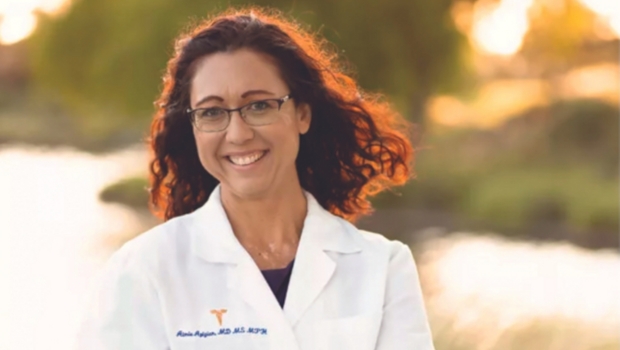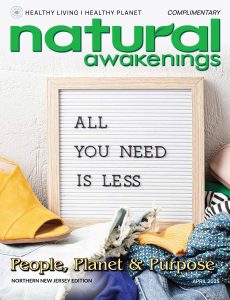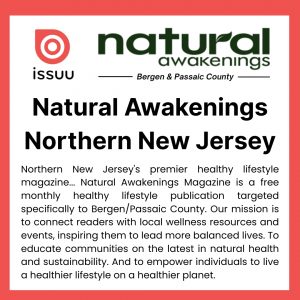Aimie Apigian on Releasing Stored Trauma
Aimie Apigian is a double board-certified physician in preventative and addiction medicine with master’s degrees in biochemistry and public health. As the founder of Trauma Healing Accelerated, she instructs individuals and practitioners on how trauma gets stored in the body and what to do once it creates a chronic health condition. Her signature methodology looks at the effects of trauma on cell biology, a missing piece in trauma therapy approaches. Patients begin with a six-week foundational journey before digging into deeper trauma work and the biology piece.
In addition to her medical degree from Loma Linda University, Apigian is a functional medicine physician specializing in neuro-autoimmunity, nutrition and genetics for addictions, mental health, and mood and behavioral disorders. She has earned certifications in trauma therapies, including somatic experiencing developed by Peter Levine, Ph.D.; the Instinctual Trauma Response Model, by Louis Tinnin, M.D. and Linda Gantt, Ph.D.; and NeuroAffective Touch, developed by Aline LaPierre, PsyD.
How do you define trauma and the trauma response?
Dr. Bessel van der Kolk uses three words to define trauma: overwhelming, unbelievable and unbearable. A trauma is something that overwhelms us in our ability to respond. We can’t believe it’s happening, and it’s so unbearable we disconnect from our body to not feel it—it’s things like loneliness, shame or abandonment.
In response to a trauma, the body disconnects, shutting down those feelings because they’re unbearable. That’s why we numb, suppress, repress, distract or avoid. The trauma immobilizes us because our ability to respond is overwhelmed. We don’t feel strong enough, big enough or smart enough; the problem or threat is too big for us, so we might as well not try.
The body shifts from using energy to conserving it, so we do only the bare minimum to get through the day—and that includes thinking; many people will have decision fatigue. There’s this sense of heaviness in the body, so we turn to caffeine and other aids. Also, the diaphragm loses its tone in the trauma response because our body goes into, “I’m going to breathe only enough to keep me alive.”
Why does trauma get stored in the body?
If there isn’t a completion of the trauma response, then the body will hold onto that trauma. Most people don’t know how to do that, let alone that this needs to be done, so they continue on with this background sense of danger, sometimes for decades. The nervous system never gets that completion that says, “That was awful, but it’s over now.” The brain never stores it as a memory of the past, which means that it’s always in our present moment.
When our whole biology continues to operate in fear, this can affect our hormones, immune system, digestion and cardiovascular system. Without a reset back to safety, we stay in danger mode and the body will close down at the cellular level. This is why people develop chronic health symptoms, and they even have a hard time absorbing nutrients because the body is just so guarded and sensitive and reactive that it won’t even be open to that.
How important is talk therapy to heal from trauma?
I consider going into your story as deeper work. That is not where we start. First, I need you to be able to stay in the present moment with me because when we go into your story, I need you to be able to stay with me. Most people don’t know how to do that because they don’t feel safe in the present moment.
Instead of starting with our story, there is an essential sequence to addressing stored trauma. We start by creating a felt sense of safety for ourselves. If we don’t create safety for our mind and body, we can develop physical symptoms as we access trauma. Also, if we attempt deeper work without that sense of safety, we get re-traumatized rather than a resolution.
How can we achieve a sense of safety?
During the first week of my foundational journey, I have people learn seven somatic exercises intended to help them create an immediate felt sense of feeling safer in their body. So no matter where they are—at the grocery store, at home—if they lose their sense of safety, they have tools in the moment to get it back.
Can you give an example of a tool?
We have different kinds of tools, and here is an example of a somatic tool. Bring your hands up as close to your shoulder as possible and imagine there’s this huge boulder in front of you. Start pushing it away, going as slow as you can. It’s not easy; you’re going to feel your arm muscles because you’re pushing hard. When you get to full extension, pause and wait for a few seconds. There are changes happening in our body, and it takes time for that message to travel up our vagus nerve to our brain stem to register. Take notice of any changes in your body. You might feel a sense of release. You might have this deep breath come that you didn’t plan for.
Another tool involves holding a pillow or blanket over your belly. You may feel a relaxation as it feels protected. The belly kind of softens for me. These are tools that you apply at any moment to bring a sense of safety to yourself.
What comes next in the sequence?
Once we create that felt sense of safety, the body is opening up, and now it needs to feel support or it’s going to go back into trauma response. From a somatic level down to the cell-biology level, we need to provide support and resources. I lead people through the process of creating a felt sense of support.
Here’s an example: Put your hands over your heart, one on top of the other, and push in quite a bit. A really deep breath comes for me; that’s how my body gives me the message that this is nice for me. Experiment and move your hands around—sometimes we can do it higher, more centered, over to the side—and find the spot that feels the nicest for your heart.
What is titrated expansion?
We each have a current capacity for how much we can hold at the moment without being overwhelmed, and I want to build my capacity so that a year from now I’m able to hold more. First, I find my current capacity by using my safety and support tools, then I learn how to grow in a way that I’m doing it while connected to my body, with my body and not pushing my body.
Many people struggle to express anger because it feels scary to them, so they hold it in, and now they have jaw tension and other symptoms. We ask, “What would be a safe amount of anger to work with right now that keeps you within your safe-enough zone?” Then we stretch that a little bit. We don’t go big because that would be too much, even though eventually we want to be able to hold a lot of capacity for being able to communicate healthy anger in a healthy way.
For many people in my courses, when they feel a lot of joy, then tears, sadness and grief seem to come, so it has been safer for them to just not feel much joy. To expand into your capacity to experience joy, you can’t go all the way immediately. You’ve got to find a safe amount of joy that you can have today that feels manageable, and then use a tool so that tomorrow you can feel a little more joy and still feel safe. We do this titrated or paced expansion, staying safe enough as we grow.
Can you explain your parts-work approach?
If we don’t complete a trauma response, there’s going to be a part that is still stuck there in that moment of danger, kind of not knowing that we survived. In parts work, I teach people how to know their major parts in order to stabilize their system. Your inner critic, for example, is a major part that we’ve got to work with pretty soon, because otherwise your critic will continue to shame you and get you into trauma response.
I guide people to notice how these parts show up in the body. When you feel that inner critic, where does she show up and how can you support her through movements and using your hands to connect with your body, giving her support and safety, and creating a relationship with that part, because it’s the relationship that then allows for the repair and the release of the trauma. Next time you feel something familiar in your body, you know, “That’s my inner critic,” and it doesn’t scare or frustrate you anymore. You’re like, “Oh, hello.” That is a true mind-body connection.
When the body has what it needs, it will do the healing and repair, which is amazing to think about. Our job is to figure out how do I give my body the safety, the energy, the time, the support that it needs for it to do the healing and repair.
Sandra Yeyati is national editor of Natural Awakenings.





























